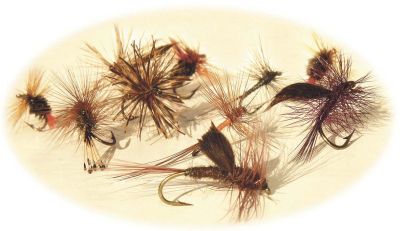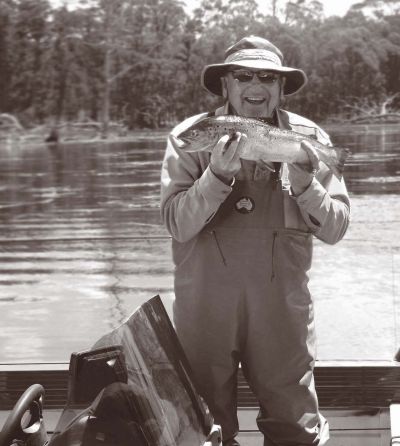 Highlands - and Arthurs Lake tips, tactics and secrets
Highlands - and Arthurs Lake tips, tactics and secrets
Presented from Issue 113, December 2014
I am probably the most frustrating angler someone could get stuck with. Why? because my very strong view is it is better to get four hours of good fishing in, rather than eight hours of poor fishing. I am a weather tragic and can spend hours in the mornings dawdling around my shack, serving coffee, drinking coffee, and holding court about where to go and what to do. Mostly everyone gets frustrated about not fishing and off they go.
The weather in Tasmania can take time to settle during the day and what is happening at 7am is often completely different to the settling weather at 11am. Many anglers drive forty five minutes only to find, as the weather settles, the location is far from ideal. However, I try to make no such mistake, and I head out when I’m reasonably sure the fishing will be good.
Photos are at the end of the article.
I want to know whether there will be blue skies, cloud or a mixture. So a late start can often be a real bonus – less fishing, but often a better location. Another reason I like a later start is because the temperature will be rising. And if that rise in temperature combines with weather clouding in you want to be on a dun fishing water – such as Pine, Woods or Arthurs.
If on the other hand the cloud doesn’t come and you get a cobalt blue sky and a rising temperature the options can be western lakes wade polaroiding – or jump in the boat like I do and get out on Great Lake for some Shark fishing or now Arthurs seems to be clearing up, you can head down there.
My decision on where I go fishing is always, totally dependent on the weather. That’s why you will see me in my shack drinking coffee with mates, often as late as noon, but be assured one eye is looking out the window watching for a change or the weather to settle.
Tasmania is unique in its weather patterns for several reasons, one being it is a small island and every part is affected by a sea breeze of some sort. Bass Strait influences this as well of course and northerly winds predominate. Even a southerly pattern can get knocked down by the northerly sea breeze.
The northerly comes in as a sea breeze with moisture and as it rises and cools over the western tiers it becomes cloud, then as it makes its way down Tasmania it clears again. I take this into account and sometimes it pays to be much further south than you would normally plan because that cloud in the morning can be quite thick, but by two o’clock the heat of the day has burnt it off.
So don’t wait for me.
I remember reading David Scholes’ Fly Fisher in Tasmania and he explains how he would sit in his Launceston office watching the sky, and if conditions turned to his liking David would do a mad dash to the Macquarie. Of course he was a wind watcher as well and also took great interest in weather patterns and the imminent summer sea breeze. David was a pilot in WWII and he would have learned a lot about weather. He carried that forward to his fishing observations and when it was right he went fishing.
The weather conditions always influence my fishing decisions. I’ll give you two examples. First thing in the morning there can be a big cloud cover coming in from the north, but looking south it is starting to gradually break and ‘blue up’. Is some cases this will have me on the southern end of Great Lake as the blue sky will move north and vision for polaroiding will improve all afternoon. Only a few kilometres away the northern end of the lake can still be in cloud and never fit for spotting fish. So even on the same lake the fishing can be poles apart. On occasion that can also apply from east to west. Sometimes I can be that frustrated at noon watching the blue trying to move up I chase the clear sky south and drive to Bronte or Dee Lagoon to get away from the cloud. I am always looking for polaroiding, because I just love sight fishing. Some anglers just want fish and dun feeders, but I always look for polaroiding opportunities first.
The 50:50 days, neither overcast nor clear blue skies frustrate me. The great days are cobalt blue skies or drizzly gray overcast day with a warm easterly. These warm easterlies can put a fog over Little Pine and Arthurs and you just know the duns will come on at three o’clock. I’d put money on it and I’m a scrooge.
Before leaving the weather and talking of other things I must say I hate fishing in the rain. The rainy days can be the best dun days ever though, and even better if it is warm and drizzly. And then there are thunderstorms. I was at Ada Lagoon with Julian Brown and a thunderstorm came rolling through. It was calm and every fish was rising, then the lightning and rain came crashing to the ground and I was scared. It passed through, went dead calm and with a heavy black thunder cloud background and sun behind us we could polaroid fish as well as on a bright blue day.
That same day I sensed something odd and I could feel my rod buzzing. I threw it up the bank thinking I might become a lightning conductor. Julian just thought I was a wimp. So thunderstorms can bring some fantastic fishing, take care and I suspect standing in a tinny with a graphite rod stuck in the air is not a good idea. So, please look at the weather maps and try and understand what it all means.
Arthurs Lake
To me Arthurs is the most important lake for anglers in Tasmania and always has been. I have fished it from the 1970s and there would not be any year it has not played a huge part in my Tasmanian summer. The last few years have not been good and there seems to have been a water quality/turbidity issue, which I would like to know more about and understand and the dun hatches have been a shadow of what they once were.
In the 1980s the dun hatches were the best in Tasmania and I remember huge rafts of duns so thick they would build up against my little Savage punt. I even saw a fish run into my boat once as it gobbled up duns unaware we were there.
Last season the fish were small, the duns seem to be returning and fish were eating them. Arthurs looks like it has turned the corner and on the way back. Those fish of half a kilo or so should be approaching one kilo and more and I am very excited at the prospect of some outstanding fishing this season.
It is a lake that has it all: windlanes, duns, nymph fishing, water snail beds, ant falls, gum beetles and more. The dun fishing, because it is so visual though is what excites me. Seeing a fish take off the top, tracking it, getting a fly in front of it and fooling it into eating your fly is the best. Interestingly Victoria has seen the return of good dun hatches in the Ballarat area this spring.
Whilst I fish in Tasmania December through to March I have plenty of spies telling me there has been good dun hatches on Woods and Four Springs, so I am optimistic. The weather I like for Arthurs can be the two options I love for many places: completely overcast or clear blue skies, without a lot of wind. However if I know the skies will be clear there are plenty of options. Some of the best fishing in Arthurs can be from the shore. Use the boat to get to a good shore and get out. I think we tend to fish from our boats too much.
In recent years turbid water has not been conducive to polaroiding, but I am led to believe the water is becoming clearer. I hope that is correct. In the past Arthurs was a water you could go to in any conditions and have a good day. If we ever doubted where to go, we simply went to Arthurs – and caught fish. It was always the backstop water and I am hoping it will be again. I am very confident.
Methods
The dun fishing when it is on means I will be fishing to moving fish so my ‘go to’ flies are always an emerger. Without doubt, for me, I find the ‘build up’ and ‘mopping up’ stages of the hatch are the best times to fool a fish. They seem to get ‘the smarts’ when the hatch is in full swing and really lock into the real insect rather than an artificial. You will see the most fish in the middle of the hatch and it is great to cast to them, but the results may not be the best.
I have always liked fishing a nymph under a foam indicator and it is now a standard Miena joke to call this a ‘Jim Allen Dry Fly’. My mate, and guide, Bill Beck gives me a hard time about it, but to me it is still a very visual way to fish. Bill thinks I should use a fly as an indicator – it would be an extra chance to catch a fish, he says.
But I like my method, I can easily see an indicator, but not a fly as well. Sometimes I want to hang two nymphs of different sizes under the indicator as well, so I am sticking to the foam indicator. I love to fish a dry fly OR really concentrate when fishing nymphs.
Depth for the bottom nymph is 300 mm above the weed, or bottom, and if using two nymphs I put the other half way to the surface. I vary these and watch the sounder to get the depth.
Striking, I believe is a learned art and to the many snatchers out there please listen. If the indicator is ‘downed’ as I call it, I want a firm positive, confident strike, as if you expect a fish to have eaten your fly. The same applies for dry fly fishing. In music you would probably describe it as ‘Staccato’, light and crisp!
Areas
My first thought when launching is to look at wind direction and then think about where I will be able to good a good drift along a shore or across a favoured weed bed.
There is some very good fishing in a couple or areas where black soil is predominant. There are a few around the lake. One is the northern end of the Cowpaddock and another is Fleming Bay. Wherever you find this black soil you will also find isopods and stick caddis. The fish love these and I like to fish around these edges, because I know the fish will be there.
There are plenty of weed beds around the lake as well and all these hold fish. One of my favourites is opposite Jonah Bay and Tea-Tree Bay also has some really good weed beds as does the eastern side of Brazendale Island.
Something I don’t do much of these days is early mornings on Arthurs fishing the foam lanes. These can be especially good on foggy mornings with little or no wind. I just head out from the ramp – and in the past this was usually the Pump House and as soon I get to a good foam lane I stop. There are ALWAYS fish in these somewhere mopping up midge or other foods.
An interesting point I’d like to make is I find two types of fish in Arthurs. Both are brown trout, but I find what I call pelagic fish in the middle of the lake. They are very silver, no colour in their spots and generally a little smaller and leaner than their weed bed cousins.
They are great eating though!
A word of caution. Arthurs Lake can become a very dangerous boating destination in big sou-westerly gales that sometimes arrive very suddenly. I always have a “safety pack” of matches, a few muesli or chocolate bars and a torch. A night in the bush will do little harm compared to a tragedy of a capsized boat!!!
Six quick questions
1. You have one day’s fish left. Where and how would you spend it?
It would be sight fishing and I have two places in mind. One would be Belize fishing for permit, which are a wonderful species to fish for, hard to catch, but very rewarding. The other option would be on Great Lake shark fishing on a cobalt blue sky day chasing those beautiful golden trout with a dry fly. I get excited just thinking about it. As far as I know this style of fishing is done nowhere else in the world.
2. You can only have one fly. What is it?
A Barry Lodge Emerger. There are other emergers, and plenty have tried to copy Barry’s, but no one has got the colour right. He was a great fly tier and I am fortunate I still have a few originals.
3. Best tip.
Go fishing. It sounds simplistic, but the more time you spend on the water the more you will learn. Keep a fishing diary. I have kept a diary from when I first fished in Tasmania. It makes fascinating reading and a lot can be learned for past entries. Learn to cast. If you can’t get the fly in front of the fish you won’t catch them.
4. Angler you most respect.
I’d have to say Bob Roles, a business partner from my past. He studies the craft intensely and tries to understand everything about the trout. What they are eating, when, how and why. He is an unhurried, patient, determined and unassuming man. When he finds a fish - and it is usually where he expects to find one, he takes the time to get into the right place to cast, chooses the right fly and makes the right presentation first time. He still weighs fish in ounces and never guesses their weight.
5. Most memorable day fishing – anywhere, ever.
It was 12th March 1986 in Tasmania and I had the Great Lake pub at the time. I drove around the highlands in a little white Suzuki and loved a walk in the western lakes. There was a little known water with very few fish in it, but they were monsters. It is now known as East Rocky Lagoon.
I had looked at this water a few times and knew one or two big fish lived there. I snuck away from the pub and in those days there were no limits as to where you could drive if you had the vehicle to get there. The Suzuki was an amazing little vehicle and would go anywhere. I made my way past Carters and hid the little 4WD near Chipman, out of sight behind a bank.
When I got back to the pub I carried in four brown trout that weighed 39 pounds. The biggest was tad over 12 pounds. We killed everything those days and I was as proud as punch showing them off to all my patrons. It is not something I would do these days, but it was normal then.
6. Favourite rod setup.
I love the new graphite rods. It astounds me how they keep improving. I tend to prefer a medium speed rod over the faster tip actions and love both the Orvis and Sage range and use a six weight.
Reels don’t matter much – they are all good and after all, only hold the line!
For lines it is always a weight forward and I go a line weight up, so a #7 on a #6 rod. These days a lot of lines are half a weight heavier as well, so a #7 is often a #7 ½. Most casting is not long distance and this extra weight is better for shorter distance, fast presentation and our windy conditions.
Leaders I still tie myself to the Ritz formulae, but usually with a longer point. They turn over well and I have never found anything better. If nymph fishing they can be lengthened to 15 feet.
Jim Allen was interviewed by Mike Stevens.
A nymph under an indicator works well when fish aren’t on the top.
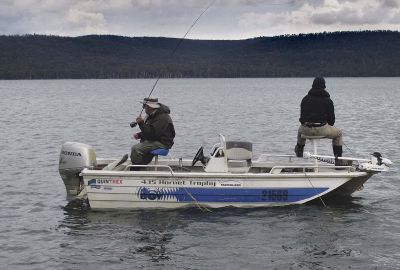
Polaroiding can be possible under heavy dark clouds.
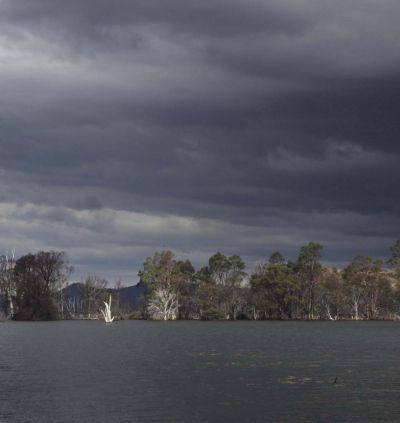
Getting out of the boat can be very rewarding.
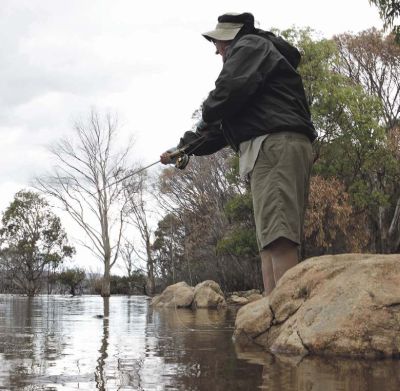
Always look for fish in the foam — on any lake.
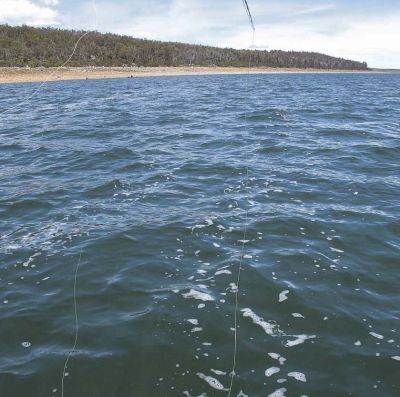
Barry Lodge flies with the Emerger front and centre.
Flies: Courtesy of HRT.
